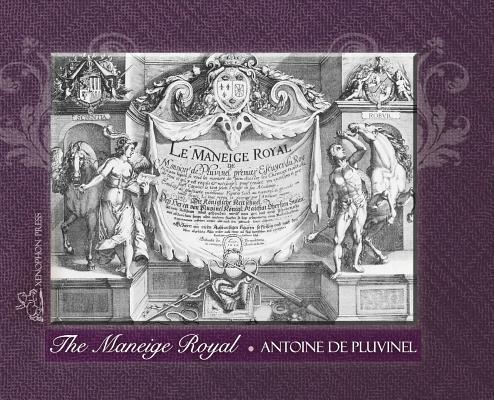Unquestionably one of the most important books ever written about the art of horsemanship, de Pluvinel's treatise is complete with the celebrated illustrations by Crispin de Pas. Translated from the 1926 edition, this is the foundation stone of any collection of equestrian literature. Pluvinel's "Le Maneige Royal" was published posthumously in 1625 in its complete form with beautiful engravings by the Flemish engraver Crispijn van de Passe II, edited by Pluvinel's friend Menou de Charnizay, under its definitive name "L'Instruction du Roy en l'exercice de monter a cheval" ("Teaching the King how to ride a horse"). Pluvinel is perhaps most well-known for his kind, humane training methods. Pluvinel used praise, careful use of aids, and softer bits (simple curb bits) to get the horse to work with him. He is also known for his extensive use of the pillars in his training of collection and levade. Additionally, he employed the two-track movements, such as shoulder-in, and voltes to supple the horse. His theories include that the horse must take pleasure in work, due to gentle, understanding riding, and that such a horse will move much more gracefully if he enjoys being ridden. 8.5"high x 11" wide Hardback, with adhered cover. Translated by Hilda Nelson.

THE MANEIGE ROYAL or L'Instruction du Roy: Wherein can be seen the Manner in which one Schools Docile Horses and everything that is required and neces
Unquestionably one of the most important books ever written about the art of horsemanship, de Pluvinel's treatise is complete with the celebrated illustrations by Crispin de Pas. Translated from the 1926 edition, this is the foundation stone of any collection of equestrian literature. Pluvinel's "Le Maneige Royal" was published posthumously in 1625 in its complete form with beautiful engravings by the Flemish engraver Crispijn van de Passe II, edited by Pluvinel's friend Menou de Charnizay, under its definitive name "L'Instruction du Roy en l'exercice de monter a cheval" ("Teaching the King how to ride a horse"). Pluvinel is perhaps most well-known for his kind, humane training methods. Pluvinel used praise, careful use of aids, and softer bits (simple curb bits) to get the horse to work with him. He is also known for his extensive use of the pillars in his training of collection and levade. Additionally, he employed the two-track movements, such as shoulder-in, and voltes to supple the horse. His theories include that the horse must take pleasure in work, due to gentle, understanding riding, and that such a horse will move much more gracefully if he enjoys being ridden. 8.5"high x 11" wide Hardback, with adhered cover. Translated by Hilda Nelson.